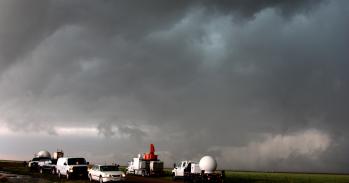
Cambridge is one of four leading UK universities awarded funding to train the next generation of researchers to become experts at assessing and mitigating risk using Big Data.
Cambridge is one of four leading UK universities awarded funding to train the next generation of researchers to become experts at assessing and mitigating risk using Big Data.
In this fast-moving, digital world, the ability to handle and analyse large volumes of complex data is vital for the UK to maintain its competitive edge
Greg Clark
Hosted as a Centre for Doctoral Training (CDT) and funded by the Natural Environment Research Council (NERC), the aim of the consortium is to produce a cohort of researchers who can use large or complex datasets to understand and ease the risks posed by a range of societal and environmental changes, such as a rapidly expanding population, limited natural resources, and natural hazards.
It’s imperative that business, government and wider society understand these risks so that they can develop appropriate mitigation strategies. Many businesses already recognise the need to understand and reduce the risks to infrastructure, operations and supply chains.
Through the insurance and reinsurance industries, for example, the UK is a world-renowned international centre in risk assessment, modelling and its application. The sector values strong collaboration with the UK academic research base to enable the improvement of their risk models, maintain a competitive edge, and grow their markets. As a result, the UK insurance sector is the largest in Europe, making a major contribution to the UK economy, employing 320,000 people and contributing almost 3% to GDP.
But other industries and humanitarian and development organisations also need the tools to help them assess the risks arising from increasingly complex and interconnected hazards, for example, international disaster risk reduction.
And, as identified by the recent BIS data strategy – Seizing the Data Opportunity – the UK has some of the best universities and institutes in the world, some truly innovative small businesses, and some of the richest historic datasets of any country.
This means there’s potential to produce a new generation of risk scientists able to maximise the opportunities big data offers, filling a skills shortage in this area. The CDT is a direct response to this shortage.
Minister for Universities, Science & Cities, Greg Clark, said: “In this fast-moving, digital world, the ability to handle and analyse large volumes of complex data is vital for the UK to maintain its competitive edge. That is why the government identified Big Data as one of our 8 Great Technologies and central to our Industrial Strategy.
“This £2.5 million investment to train the next generation of Big Data experts will enable a skilled workforce to develop innovative tools to assess and mitigate risk that will help business, government and wider society cope effectively with big environmental and societal changes.”
Professor Simon Pollard of Cranfield University will lead the consortium, called DREAM (Data, Risk and Environmental Analytical Methods). It will include researchers from the University of Cambridge, Newcastle University and the University of Birmingham, together with a wide range of partners from the private and public sectors. Dr Mike Bithell from Cambridge’s Department of Geography is one of four centre directors for the programme.
Funding for ten studentships will be awarded each year. The CDT award will provide funding for three years of new student intake – 30 studentships in total – from 2015 to 2016. Two of the studentships in the 2016 cohort will be interdisciplinary and co-funded by the Economic and Social Research Council (ESRC) and NERC.
Students will gain advanced technical skills, be regularly brought together as a cohort to share ideas and skills, and have the opportunity to take part in partner-based secondments.
CDTs support strategically-targeted, focused PhD studentships aimed at addressing specific research and skills gaps.
The text in this work is licensed under a Creative Commons Licence. If you use this content on your site please link back to this page. For image rights, please see the credits associated with each individual image.





